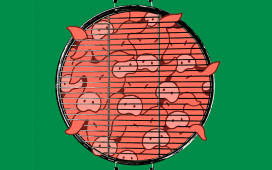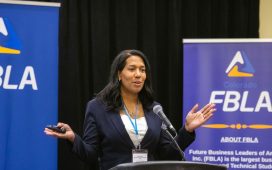In March of last year, when the emergence of the COVID-19 pandemic had knocked the American economy into an unprecedented free fall, Austan Goolsbee, an economist at the University of Chicago who served as chair of the Obama White House Council of Economic Advisers, pointed out what he called the first rule of virus economics: “slowing the virus is the way to fix the economy.” At the time, Donald Trump and other Republicans were criticizing the lockdowns that New York, California, and other Democratic-run states had introduced, citing their punishing impact on the economy. To test this claim, Goolsbee and a colleague examined activity in roughly 2.25 million businesses across the country, comparing consumer behavior across cities to different lockdown responses.
They found that the main force driving people’s economic behavior wasn’t the lockdown but the spread of the coronavirus. Wherever death rates increased, people cut back their visits to businesses at pretty much the same rate—regardless of whether there was a local lockdown order in place. For example, visits to beauty salons in Bettendorf, Iowa, where there was no lockdown restriction, fell by about the same amount as visits to beauty salons across the border in Illinois, where there was a statewide stay-at-home order. “It really is not about the lockdown order, it’s about people getting scared,” Goolsbee explained at a conference last December. “So, what that tells us now is that if the virus starts really spreading again, it could seriously undermine consumer activity.”
Economic data during the surge in infections at the end of 2020 confirmed his point. As case numbers rose, spending slowed and employers paused hiring: that December, payrolls fell by three hundred and six thousand, before bouncing back in February and March of 2021, as the number of cases fell sharply. This summer, many economists hoped that the onset of mass vaccinations would break the link between the virus and the economy, but this has not been borne out. Following a rapid spread of the Delta variant, the job figures for August showed a big fall-off in hiring compared with the previous two months, and other recent statistics have also pointed to a significant slowdown. When I spoke with Goolsbee, on Friday afternoon, he sounded deeply relieved that the policymakers in the White House had taken drastic action to address the current COVID surge. “I think that, if they can’t get control of this thing, it is going to end the recovery prematurely,” he said. “The recovery hasn’t stopped yet, and it’s not too late to get control of the virus. But boy, this had the smell of something bad—and of something worse to come.”
As the number of infections has risen over the past couple of months owing to the Delta variant, individuals have again altered their behavior. Restaurant bookings are down. Several major airlines said last week that their bookings for the fall were substantially weaker than expected. Goolsbee told me that he had just received a note from his daughter’s college, saying that a parents’ day later this term, which had been scheduled to be in-person, would instead be held virtually. “Now everyone is going to cancel their flights and hotels and car rentals,” he predicted. “That, writ large, is exactly what you are seeing across the economy.” On Wall Street, economists are busy slashing their forecasts for G.D.P. growth in the third quarter. As recently as late August, Goldman Sachs was predicting growth of five and a half per cent; now it is predicting three and a half per cent. This week will see the release of new data on retail sales and industrial production. If they come in weaker than expected, the G.D.P. projections could come down even further.
In announcing the new vaccine mandate and other COVID policies, the White House promoted them as public-health measures. But Biden’s economic advisers, who didn’t appear at Thursday’s announcement, have long shared Goolsbee’s belief that checking the virus is of paramount importance for reviving the economy. The recovery “will not be complete until the public health situation is under control,” Cecilia Rouse, the chair of the White House Council of Economic Advisers, wrote in a blog post after the release of the disappointing August job figures.
Arguably, the Administration should have moved earlier. The slowdown in the pace of vaccinations earlier this summer, and the rapid spread of the Delta variant in India and the United Kingdom, were both warning signs that the crisis was not yet over. Now that the Administration has shifted course, a rapid implementation of its new policy will be critical. The plan is for the Occupational Health and Safety Administration to issue a new rule ordering all businesses that employ at least a hundred people to require vaccinations or weekly testing. This rule hasn’t been issued yet, though, and it will likely face a slew of legal challenges.
Assuming that the new policy goes into effect quickly and is upheld by the courts—two non-trivial assumptions—it could have a major impact on the over-all vaccination rate. Until now, many big businesses, particularly those that employ a lot of unskilled workers, have been reluctant to impose a vaccine requirement because they fear losing workers to rival firms that don’t have one. “Nobody wants to be the first: it’s much easier if they all do it together,” AnnElizabeth Konkel, an economist at the job site Indeed, told me. Konkel has been tracking the number of job ads that mention vaccine requirements. In August, it more than doubled, but from a low base. “I expect the trend to accelerate rapidly now,” she told me. “For many employers who have been on the fence, the fact that the federal government is going to require a vaccine—I suspect that will push them over the edge.” Backing up this theory, the Business Roundtable, which represents the C.E.O.s of many big companies, issued a statement supporting the new proposals.
Conceivably, the vaccine requirement could also help persuade more people to reënter the work force and look for jobs. At the start of the pandemic, the labor-force participation rate fell sharply, and it’s still well below its normal level. A number of COVID-related factors appear to also be playing a role in keeping people out of the workforce, including a fear of getting infected and a lack of adequate child care. “Our surveys show that COVID is still a concern for job seekers; it’s still on their minds,” Konkel said. By extension, anything that reduces this concern and improves the public-health outlook should help to increase the supply of workers, which could relieve a labor shortage that is affecting many parts of the economy.
That’s the optimistic scenario—one in which rising vaccination rates help to reduce the spread of the virus, restore public confidence and lift the economy back onto a higher growth path. There are also darker scenarios, of course, including the possibility that fears about breakthrough infections have a longer-lasting economic impact, or even that, heaven forbid, a variant more resistant to the current vaccines emerges. Right now, though, with the economic recovery showing signs of sputtering, the primary task is to curb the spread of the Delta variant, and that is what the White House is attempting to do. “There isn’t anything that the Administration could do that is more important,” Goolsbee insisted.








